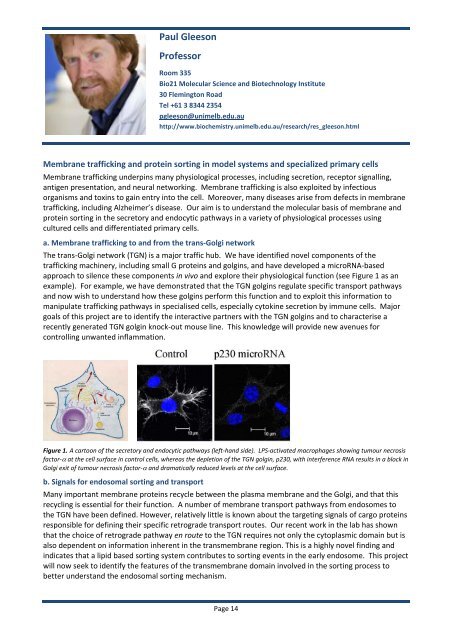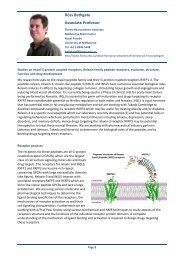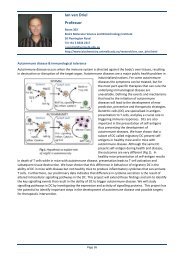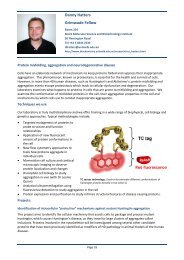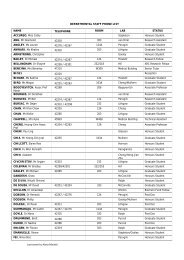Paul Gleeson Professor
Paul Gleeson Professor
Paul Gleeson Professor
Create successful ePaper yourself
Turn your PDF publications into a flip-book with our unique Google optimized e-Paper software.
<strong>Paul</strong> <strong>Gleeson</strong><br />
<strong>Professor</strong><br />
Room 335<br />
Bio21 Molecular Science and Biotechnology Institute<br />
30 Flemington Road<br />
Tel +61 3 8344 2354<br />
pgleeson@unimelb.edu.au<br />
http://www.biochemistry.unimelb.edu.au/research/res_gleeson.html<br />
Membrane trafficking and protein sorting in model systems and specialized primary cells<br />
Membrane trafficking underpins many physiological processes, including secretion, receptor signalling,<br />
antigen presentation, and neural networking. Membrane trafficking is also exploited by infectious<br />
organisms and toxins to gain entry into the cell. Moreover, many diseases arise from defects in membrane<br />
trafficking, including Alzheimer’s disease. Our aim is to understand the molecular basis of membrane and<br />
protein sorting in the secretory and endocytic pathways in a variety of physiological processes using<br />
cultured cells and differentiated primary cells.<br />
a. Membrane trafficking to and from the trans‐Golgi network<br />
The trans‐Golgi network (TGN) is a major traffic hub. We have identified novel components of the<br />
trafficking machinery, including small G proteins and golgins, and have developed a microRNA‐based<br />
approach to silence these components in vivo and explore their physiological function (see Figure 1 as an<br />
example). For example, we have demonstrated that the TGN golgins regulate specific transport pathways<br />
and now wish to understand how these golgins perform this function and to exploit this information to<br />
manipulate trafficking pathways in specialised cells, especially cytokine secretion by immune cells. Major<br />
goals of this project are to identify the interactive partners with the TGN golgins and to characterise a<br />
recently generated TGN golgin knock‐out mouse line. This knowledge will provide new avenues for<br />
controlling unwanted inflammation.<br />
Figure 1. A cartoon of the secretory and endocytic pathways (left‐hand side). LPS‐activated macrophages showing tumour necrosis<br />
factor‐α at the cell surface in control cells, whereas the depletion of the TGN golgin, p230, with interference RNA results in a block in<br />
Golgi exit of tumour necrosis factor‐α and dramatically reduced levels at the cell surface.<br />
b. Signals for endosomal sorting and transport<br />
Many important membrane proteins recycle between the plasma membrane and the Golgi, and that this<br />
recycling is essential for their function. A number of membrane transport pathways from endosomes to<br />
the TGN have been defined. However, relatively little is known about the targeting signals of cargo proteins<br />
responsible for defining their specific retrograde transport routes. Our recent work in the lab has shown<br />
that the choice of retrograde pathway en route to the TGN requires not only the cytoplasmic domain but is<br />
also dependent on information inherent in the transmembrane region. This is a highly novel finding and<br />
indicates that a lipid based sorting system contributes to sorting events in the early endosome. This project<br />
will now seek to identify the features of the transmembrane domain involved in the sorting process to<br />
better understand the endosomal sorting mechanism.<br />
Page 14
c. Regulated endocytosis<br />
Macropinocytosis is a regulated form of endocytosis and is highly active in macrophages and dendritic cells<br />
(antigen presenting cells) where it is a major pathway for the capture of antigens. Despite the importance<br />
of this pathway, the molecular basis for the formation and maturation of macropinosomes is poorly<br />
defined. This project aims to investigate the role of macropinocytosis in antigen uptake by macrophages<br />
and dendritic cells using cell lines and genetically modified mouse lines.<br />
Autoimmunity and molecular immunology<br />
Failure of immunological self‐tolerance often leads to the development of autoimmune diseases, which<br />
afflict up to 5% of the population. The underlying causes of autoimmune diseases are still unknown,<br />
although infections are strong candidates for initiating autoimmunity by promoting the maturation of<br />
dendritic cells (DCs) that present tissue self‐antigens. This project will analyse the relationship between<br />
inflammatory stimuli, the maturation status of DCs that present gastric self‐epitopes and the development<br />
of organ‐specific autoimmunity.<br />
Figure 2. Gastric cells express an<br />
autoantigen which is presented in<br />
the local draining lymph nodes by<br />
migratory dendritic cell<br />
We have established an experimental autoimmune disease of the stomach<br />
(autoimmune gastritis) as a powerful model of organ‐specific autoimmunity<br />
and have identified the gastric autoantigens that are recognized by the selfreactive<br />
effector T cells. CD4 + T cells that mediate the disease recognize the<br />
highly abundant gastric H/K ATPase heterodimer. Immune tolerance to these<br />
gastric self‐antigens occurs primarily in the periphery. Most importantly, we<br />
have also identified a subpopulation of migratory DCs in the draining lymph<br />
node of the stomach that presents the endogenous gastric H/K ATPase<br />
antigen. Hence, we are now able to compare the status of DCs which present<br />
the gastric antigen, from normal mice and mice with autoimmune gastritis, as<br />
a basis for understanding the shift from tolerance to autoimmunity. This<br />
project will involve the isolation of the migratory population of DCs by<br />
standards methods in the lab, analysis of TLR expression of these migratory<br />
DCs and assessment of the impact of different TLR ligands on the maturation<br />
and functional status of these DCs by analysis of cytokine profiles and<br />
activation of gastric‐specific effector T cell responses.<br />
Recent publications<br />
1. van Driel IR, Read S, Zwar TD, <strong>Gleeson</strong> PA. (2005) Shaping the T cell repertoire to a bona fide autoantigen: lessons from<br />
autoimmune gastritis. Curr Opin Immunol, 17, 570–6.<br />
2. Kerr M.C., Lindsay M.R., Luetterforst R., Hamilton N., Simpson F., Parton R.G., <strong>Gleeson</strong> P.A., Teasdale R.D. (2006).<br />
Visualisation of macropinosome maturation by the recruitment of sorting nexins. J. Cell Sci. 119:3967‐80.<br />
3. Derby MC, Zhao Lieu Z, Stow J, Goud B, <strong>Gleeson</strong> PA. (2007). 'The TGN golgin, GCC185, is required for endosome to Golgi<br />
transport and maintenance of Golgi structure'. Traffic, 8: 758–73<br />
4. Read S, Hogan T, Zwar T, <strong>Gleeson</strong> PA, van Driel IR. (2007) 'Prevention of autoimmune gastritis in mice requires extrathymic<br />
T cell deletion.' Gastroenterology, 133(2):547‐58<br />
5. Lieu, Z.Z., Lock, J.G., Hammond, L.A., La Gruta, N. L, Stow, J. L. and <strong>Gleeson</strong>, P.A. (2008). A trans‐Golgi network golgin is<br />
required for the regulated secretion of TNFa in activated macrophages in vivo. Proc. Natl. Acad. Sci USA, 105:3351‐6<br />
6. Houghton F, Chew PL, Lohedo S, Goud B and <strong>Gleeson</strong> PA (2009) The localization of the golgin, GCC185, is independent of<br />
Rab6 and Arl1. Cell 138: 787‐794<br />
7. <strong>Gleeson</strong> PA and Goud, B (2010) TGN golgins, Rabs and cytoskeleton: Regulating the Golgi trafficking highways. Trends<br />
Cell Biol 20(6):329‐36.<br />
8. Chia, PZC and <strong>Gleeson</strong>, PA (2011) The regulation of endosome‐to‐Golgi retrograde transport by tethers and scaffolds.<br />
Traffic (in press)<br />
Page 15


